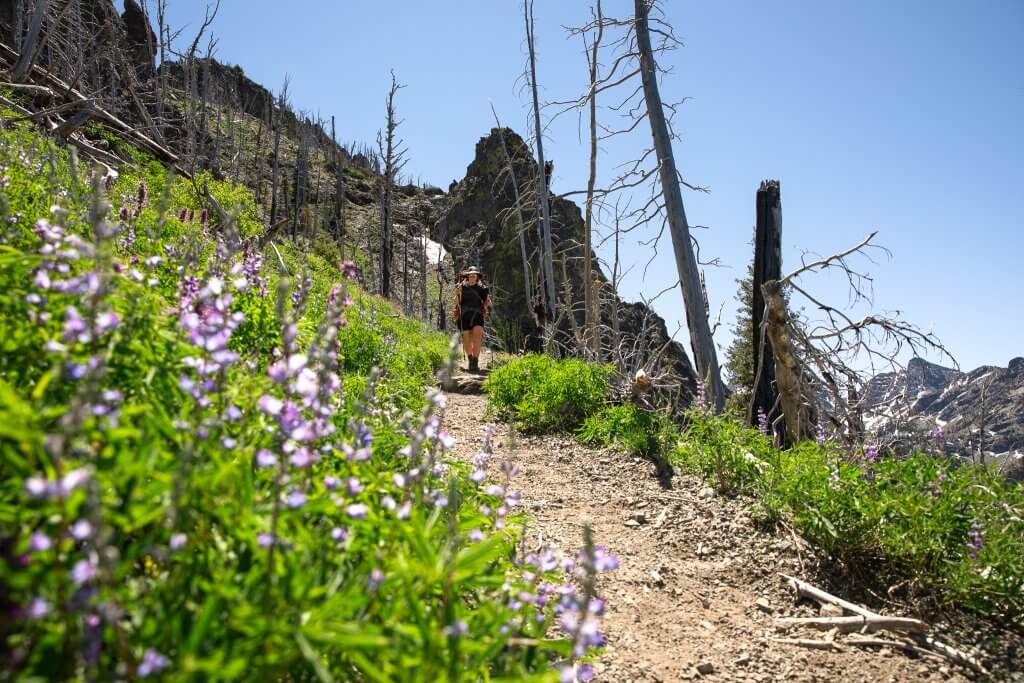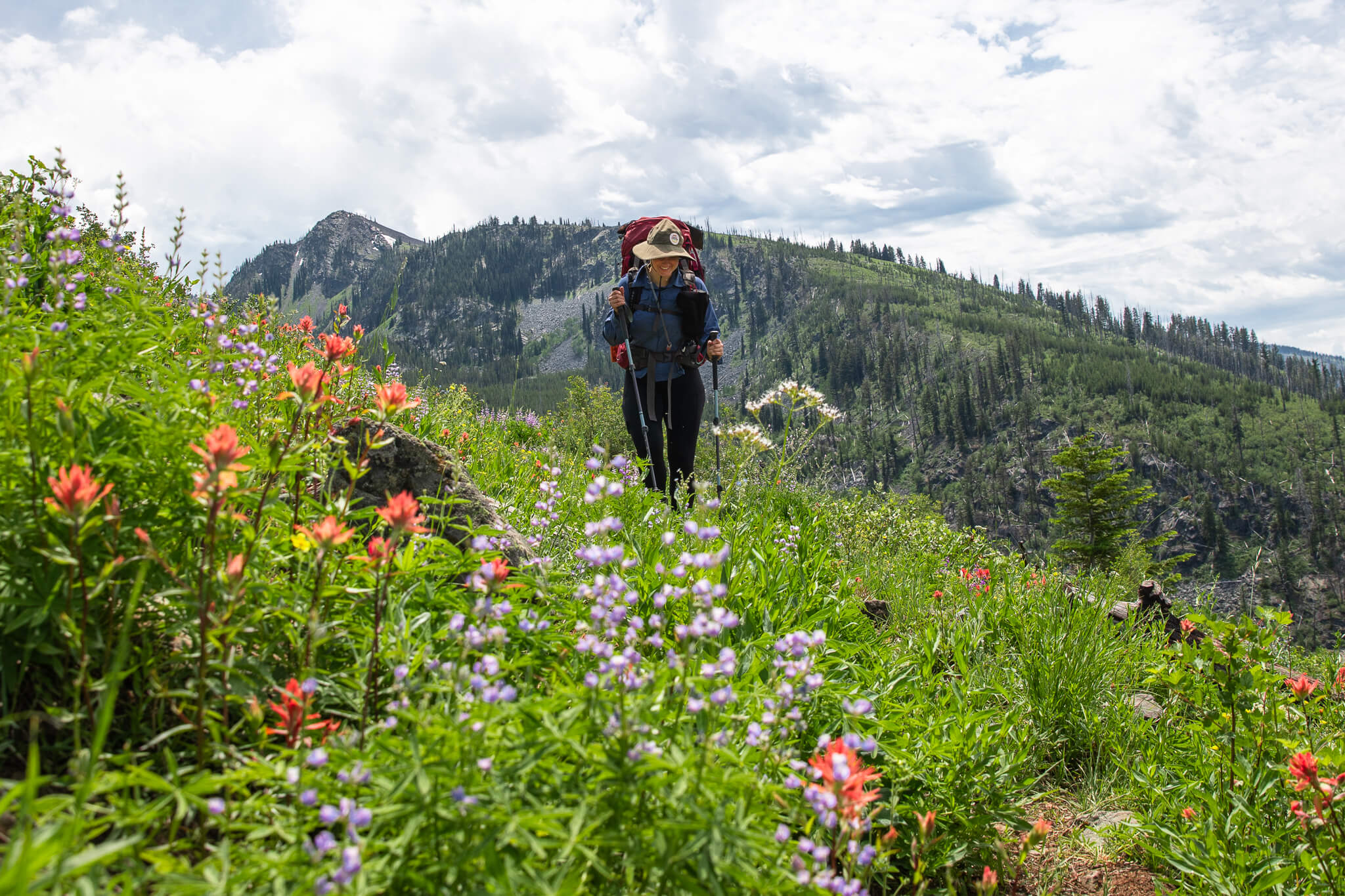The Seven Devils Mountains sit on the east side of Hells Canyon Wilderness, which covers 218,000 acres of rugged terrain between Idaho and Oregon. The landscape varies between verdant meadows, craggy peaks and talus fields, but solitude is the one constant you’ll find here. The Windy Saddle Trailhead provides access to alpine lakes and many of the summits via the Seven Devils Trail #124 and the South Boise Trail #101A, which link to form the Seven Devils Loop.

Preparing for the Seven Devils Loop Trail
I timed my visit to the Seven Devils just after the snow melted—and during the peak of wildflower season, which is generally in mid-July. My friend and I were also hiking on the heels of a trail crew who cleared hundreds of downed trees along the route. Due to a number of major wildfires over the years, the area is notorious for having a significant amount of blowdown, which can make some sections challenging. There is a nearly nine-mile stretch in the middle of the loop with no water sources, and since Hells Canyon Wilderness regularly sees sweltering daytime highs in July and August, it is important to start early, take rest breaks and carry plenty of water. We chose to hike the loop counter-clockwise because the uphill stretches didn’t seem as long in that direction, and I had a few specific campsites in mind. However, plenty of hikers do the loop clockwise, and there are pros and cons to both directions.
Rattlesnakes are prevalent along open ridges and near the river in Hells Canyon, but I was thrilled to learn that they are not a concern on the loop trail. Black bears are present in the Seven Devils, so hikers and backpackers are advised to carry bear spray, make plenty of noise, use a bear can (or a proper bear hang) and pack out all food waste. Despite online reports to the contrary, dogs are allowed on the Seven Devils Loop, but they must be under control at all times (i.e., on a leash or under strict voice command) so as not to disturb wildlife or pack stock. Finally, while fires are permitted in the established backcountry sites along the loop, there are often restrictions in the summer, so visitors should always check with the US Forest Service ranger station in Riggins for the latest updates.
Day 1: Windy Saddle Trailhead to Basin Lake

Forest Road 517 to Windy Saddle Trailhead is a mix of gravel and dirt, and while RVs and trailers are not advised, a 4×4 vehicle is not necessary. Pit toilets are available at the nearby Seven Devils campground and at the trailhead. If you plan to hike the loop clockwise, start by following signs for Sheep Lake via Seven Devils Trail #124. The trail is surrounded by dead trees and a barren landscape for the first two miles, but just before the three-and-a-half-mile mark hikers are rewarded with shade from the forest, plus a flowing creek next to the trail. The stream crossings require careful foot placement on slippery logs, but they are neither deep nor treacherous.
After crossing the east and west forks of Sheep Creek, Trail #124 intersects Trail #140 and Trail #57, the latter of which leads to Bernard Lakes and Dry Diggins Lookout. We considered dumping our overnight gear at the junction and hiking to the lookout, but that would have added three more miles to our distance that day, and we were already burnt out. Basin Lake is just a mile and a half from the junction via Sheep Lake Trail #123, so it’s an appealing place to camp. From Windy Saddle to Basin Lake, we logged 6.5 miles and 1,600 total feet of gain. While this looks like an easy day on paper, we had a late start, and the heat hit us hard. I drank more than three liters of water, and we took countless rest stops to catch our breath and cool down on the rare occasion that we found a patch of mosquito-free shade.

Backpackers will also find campsites at Shelf and Gem Lakes, which are half a mile beyond Basin Lake. Sheep Lake is also an option, but it’s another two miles from Basin Lake and a bit of a bushwhack. Please note: Trail #123 to Basin, Gem, Shelf and Sheep Lakes via Seven Devils Trail #124 is not connected to the off-trail, unofficial “shortcut” from the Seven Devils Campground. The Sheep Lake shortcut appears on several route-sharing apps, and while it shaves off a significant amount of mileage, is a hazardous scramble, and the majority of rescues in the Seven Devils occur along this ridge.
Day 2: Basin Lake to Baldy Lake

The hike out of Basin Lake was about a mile and mostly flat, as was the next mile on Seven Devils Trail #124. However, after two more miles of easy downhill, our pace slowed when we encountered several dozen downed trees. While the trail crew had cleared almost everything between Windy Saddle and Basin Lake, this quarter-mile stretch was a different story. Some trees were easy to step over, but other sections were more difficult, and twice we had to take our packs off and pull them under massive trunks. It wasn’t impossible or technical, but it slowed us down by about ten minutes, and it certainly wouldn’t have been safe for equestrians and pack stock. The final mile to Baldy Lake took us up another few hundred feet, but it was gradual and easy. From Basin Lake to Baldy Lake, we logged seven miles and 1,150 total feet of gain, which allowed us to take plenty of breaks to photograph the incredible wildflower displays right next to the trail.

We found several flat campsites tucked in the woods behind Baldy Lake, many of which had log benches, which was a treat. We were warned of aggressive rodents and mountain goats in the Seven Devils, so in addition to bringing a bear can for food, toiletries and trash, we hung our packs and hiking poles before we tucked into our sleeping bags each night. Salt from human sweat can be very enticing to some critters, and they will chew anything that smells or tastes like it. Earlier that day we bumped into a fellow backpacker hiking from Baldy Lake to Windy Saddle and marveled at the damage on one of his hiking poles. Not only was the strap chewed right off, but so was 90% of the handle!
Day 3: Baldy Lake to Dog Creek

Before leaving camp at Baldy Lake, we filled every water bottle and filter bag we had, as our next water source was nine miles away at Dog Creek. After an easy mile back to Trail #124, we gained 1,400 feet over the course of the next three miles. While it wasn’t steep, the majority of the trail was exposed to the sun, and we were definitely feeling the weight of the extra water. (I drank three liters on our first day, so I opted to carry four liters, which added nearly nine extra pounds to my pack weight.)
Just before hiking past Pyramid Mountain, we encountered the last remaining snowfield on the trail, which we were able to side-step via a small goat trail below. However, two weeks earlier this might not have been possible, and the crossing would have been much more technical. Almost immediately after passing the snow, the rocky landscape opened up to a beautiful alpine meadow that seemed to go on forever …

Shortly after crossing the meadow, Trail #124 meets with Trails #114 and #214, the latter of which leads to Horse Heaven and even more alpine lakes. At the Horse Heaven junction, Trail #124 ends, and hikers heading back to Windy Saddle switch to the South Boise Trail #101A. Two miles after the junction, we spotted a tarn on the east side of Trail #101A, but it was filled with brown water and surrounded by downed trees. Dog Creek was just two miles farther, and we each had a liter of water left, so we kept moving.
Not only did we find a blissfully cold water source at Dog Creek, but there were several cowboy camps (i.e., large, established backcountry sites with log benches and ample space for tents and stock) just a quarter of a mile from the junction with Trail #101A. We were planning on camping at Dog Lake, which was just a mile up the trail, but after hearing reports of more downed trees, we dumped our packs and gave it a quick scout. While it was beautiful, sure enough, the trail seemed to disappear after five minutes of hiking, so we returned to the cowboy camp and called it a day. We ended up logging 9.5 miles and 1,400 total feet of gain, with just as much descent.
Day 4: Dog Creek to Windy Saddle
While the trek from Dog Creek to Windy Saddle was just seven miles, we stopped by Lower Cannon Lake on the way out, adding a mile and three quarters, plus 600 feet of gain. If you have the time, this gem of an alpine lake is worth the extra distance, and we spotted at least one large campsite, too.

We collected our gear from the junction and continued on, and the next mile and a half was a breeze. However, the final mile and a half back to Windy Saddle was all uphill, and though it only climbed 1,000 feet, it felt much steeper in the heat of the afternoon. Including our side trip to Lower Cannon Lake, plus accidentally hiking up a section of road instead of the trail at the end, we logged 9 miles and 1,500 total feet of gain on our final day.
After the 45-minute drive back to Riggins, we were ravenous. We had been dreaming about the burgers and huckleberry cider at the Seven Devils Bar and Steakhouse all day, and it was the perfect post-hike meal. And after cleaning up at the Big Iron Motel and sleeping in well past sunrise, I was ready for the next adventure: rafting Hells Canyon.
Closing Thoughts
We hiked 33 miles with 5,650 total feet of gain over the course of four days. While that may seem mellow, the heat and sun exposure slowed me down tremendously, and even though there is no off-trail travel or scrambling, I wouldn’t say this route is beginner-friendly. Taking it slow is the secret to enjoying the Seven Devils Loop, so consider cutting your usual daily mileage by at least a third on this route.
I’m glad I ticked the Seven Devils Loop off of my list of Idaho backpacking treks, but when I go back, I’ll likely set up base camps at more accessible lakes, like Baldy or Lower Cannon, and spend a few days exploring the surrounding areas. While the Seven Devils Mountains don’t offer the same kind of breathtaking scenery as the Sawtooths, this range has no shortage of natural wonders. I can’t remember the last time I saw a landscape change so much around every bend on the trail—or found this level of peace and quiet in the mountains.
For more information on trail conditions in the Seven Devils Mountains, please contact the US Forest Service Office in Riggins at 208-628-3916, or check the US Forest Service website for the Wallowa-Whitman National Forest.
Not ready for a multiday hike in the Seven Devils? Check out these day hike options in these beautiful and rugged mountains.
Feature image credited to Elisabeth Brentano
Elisabeth Brentano is a writer and photographer based in California, but her passion for nature takes her all over the world to produce travel and environmental content. You can follow her at @elisabethontheroad on Instagram.
Published on July 31, 2023

